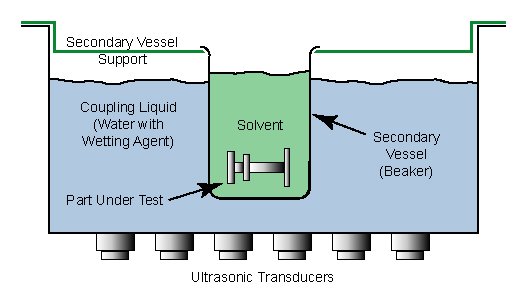Although manual re-washing techniques for harvesting particles are effective for a wide range of particle types and sizes, they may fall short in collecting particles that are very small (less than 10 or 20 microns) or difficult to remove from the surface of the substrate for one reason or another. Ultrasonics, which has long been the “gold standard” of cleaning, may be an answer when manual techniques fall short. Ultrasonic energy can remove particles from areas where spray and brush techniques can’t reach and is also extremely effective at removing small particles. Even particles smaller than one micron in size are a cinch for ultrasonic cleaning.
Particle Harvesting Using Ultrasonics –
One common technique for harvesting particles using ultrasonics is to partially immerse a glass or other rigid, non particle shedding beaker or other vessel containing a solvent and the part under test in an ultrasonic tank filled to a prescribed depth with water. The ultrasonic energy is delivered or “coupled” to the solvent through the walls of the secondary vessel and, in turn, to the substrate surface by the solvent.

Some of the basic rules don’t change much when using ultrasonic energy to harvest particles. Cleanliness of the equipment and consistency in technique are still important. Any specification should detail the procedure for preparing the collection solvent and the secondary vessel used for collection. There are, however, some other not so obvious variables that are important to maintain a consistent and meaningful “particle harvest” using ultrasonics.
Ultrasonic Consistency –
A rose by any other name is still a rose. This is not necessarily so in the case of ultrasonic cleaning tanks. Frequency, waveform and ultrasonic power differ not only from manufacturer to manufacturer but from model to model as well. Even the same ultrasonic cleaning tank may produce differing results depending on variables including the efficiency of the coupling of ultrasonic energy into the secondary vessel, temperature, degassing and the liquid level in both the ultrasonic cleaning tank itself and in the secondary vessel. The physical properties of the secondary vessel should also be consistent – beaker manufacturer and size, for example. All of these variables must be rigorously controlled, and are often not a part of the specification. It is important to be aware of these “hidden” variables and address them.
Ultrasonic Transparency of the Secondary Vessel –
One frequent mistake is the use of a plastic or extremely thick-walled beaker or other container as the secondary vessel in the arrangement illustrated above. Plastic and/or thick-walled vessels may not conduct ultrasonic energy well at some frequencies and should be avoided. Glass is probably the best conductor of ultrasonic energy with stainless steel a close second. Before deciding on a vessel to use, testing should be done to verify that ultrasonic energy does, indeed, reach the solvent contained in the vessel and that it cavitates the solvent effectively.
Part Coverage –
Part orientation during testing may also be a major consideration. For the ultrasonic energy to be effective, the solvent must contact the surfaces under test. A part with blind holes or other contours that trap air bubbles may necessitate part rotation to assure that ultrasonic energy reaches all surfaces. Again, this procedure should be specified in detail.
The next blog will discuss addressing particles that may not really count.
– FJF –



 English
English Spanish
Spanish Chinese
Chinese Canada
Canada Mexico
Mexico United Kingdom
United Kingdom



